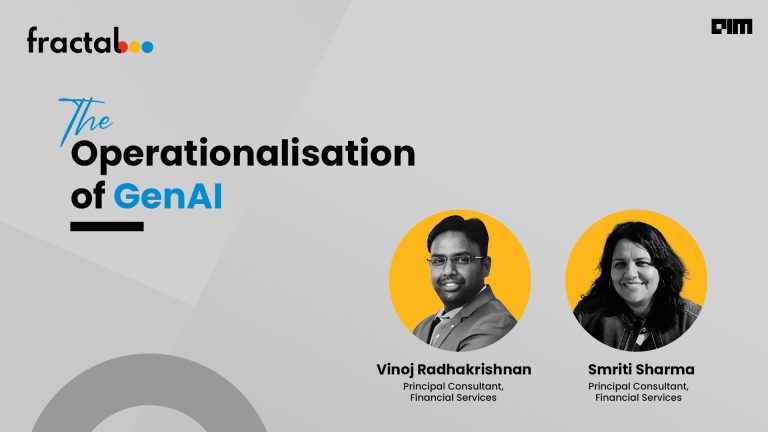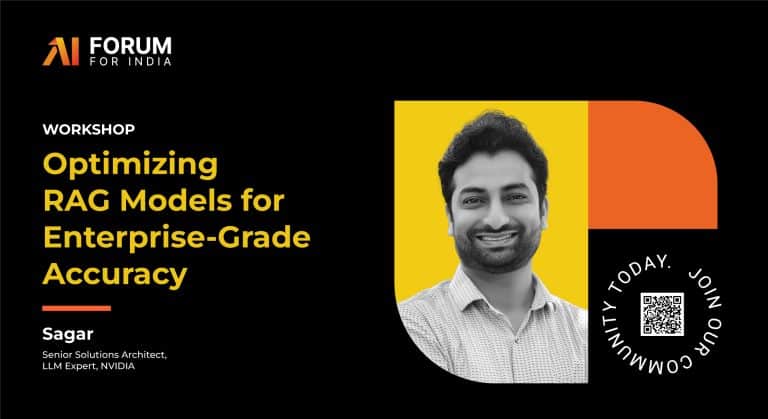In the ever-evolving world of fashion often marked by a dichotomy between ethnic styles and emerging trends, demand forecasting and sustainable sourcing, loss prevention and inclusive sizing- the integration of cutting-edge AI technologies has always furnished valuable insights towards decision making, and has established itself as a catalyst for transformation in this industry.
Machine vision, often referred to as computer vision, stands as a paradigm of non-invasive AI technology with transformative potential across various industries. This cutting-edge field involves the development of systems that empower machines to interpret and understand visual information, mimicking human vision capabilities.
Dr. Prosenjit Banerjee, Director of Machine Vision Practice and Research, AI Team at Fractal Analytics, delves into the transformative impact of advanced Machine Vision algorithms, especially the overall progress made towards development of foundation models in vision and vision-language and Generative AI in the machine vision domain in general, and its impact across the fashion and apparel supply value chain.
“To understand how machine vision helps in the fashion field, we will have to understand the value chain of the industry,” said Prosenjit Banerjee, in an exclusive interaction with AIM as he takes us through the various stages in fashion production and design process and explains how machine vision is making a significant impact as a decision making and productivity tool.
Fabric Production Automation
The process commences with fabric production for the apparel sector. Fabric production process encompasses spinning, weaving, dyeing, and printing fabric rolls. The fabric’s quality significantly influences subsequent ‘sourcing’ process. Each garment design necessitates specific characteristics like durability, breathability, and color fastness. Rigorous evaluation, tests, and certifications ascertain the selected fabrics meet required standards.
Automatic optical inspection systems using industrial cameras have simplified the quality assurance process in fabric production by modelling the process of defect detection. Detecting fabric issues such as knots, stains, pilling, and weaving irregularities, machine vision – employing advanced image processing and machine learning, ensures a proper quality label to the produced fabric, thereby pioneering non-destructive testing standards towards Industry 4.0 and setting new industry benchmarks for flawless, high-quality fabrics.
As Prosenjit explains, these automated optical inspection systems based on machine vision approaches were in practice for a long time now. The current developments in the machine vision domain – especially foundation models have reduced the data requirement for these processes by several folds, thereby providing easier scaling and facilitating quicker automation strategies in place. The model training times have also reduced by several folds owing to the application of zero-shot and few-shot training techniques.
Fabric Sourcing – Trend and demand analysis
Comprehending fabric requirements stands as a pivotal element in garment design and manufacturing. Precise fabric estimation ensures the acquisition of an optimal quantity, preventing wastage or shortages. A successful sourcing strategy involves understanding consumption patterns, determining fabric dimensions, adhering to quality standards, and considering factors such as shrinkage and prewashing effects.
In the fiercely competitive fashion sector, the imperative of a well-defined fabric sourcing strategy is heightened by rapid competition and brief product life cycles. Brands vie for supremacy by promptly adapting to market-driven trends, while adhering to robust fashion trend analysis. This analytical approach grapples with the intricate facets of consumer preferences, presenting a challenge in modelling both visual appearance (style analysis) and temporal evolution.
Machine vision tasks, spanning object detection, recognition, and segmentation, continuously refine cloth classifications, attribute predictions, and clothing image retrievals, playing a pivotal role in shaping the industry’s response to dynamic fashion landscapes. Foundation models in vision like the Segment Anything Model (SAM) and self distillation with no labels (DINO, DINO v2) have further brought the properties of self-supervised vision transformers to this domain, thereby enabling better feature representation.
The machine vision team at Fractal Analytics analyses vast visual data, decoding emerging trends and consumer preferences and offering their developments as reusable APIs. These model API’s contribute to sentiment analysis, providing valuable insights into consumer reactions and enabling brands to make informed, data-driven decisions.
Igniting creativity in Apparel Design, Fashion Stylisations and Marketing
Apparel design and fashion technology represent the dynamic intersection of creativity and innovation in the fashion industry. Apparel design is the creative process of conceptualizing, sketching, and developing clothing and accessories. Designers draw inspiration from cultural trends, historical styles, and personal creativity to create unique and aesthetically pleasing garments.
They consider fabric choices, color palettes, and garment construction techniques. Foundation models in machine vision, along with stable diffusion and Generative AI leverages powerful algorithms and massive datasets to generate unique and innovative designs, patterns, and styles in fashion. It also allows fashion designers and brands to streamline their creative processes, reduce production times, and explore new creative ideas.
In the realm of marketing, the machine vision team at Fractal have been working on redefining content creation with vision-language models, graphic generation techniques like stable diffusion, visual prompting, and LLM based prompting techniques. Understanding the interplay between images and text, these models aid in crafting compelling brand narratives and visually stunning marketing materials. These models help in analysing social media graphical content, providing insights into consumer sentiment and preferences for more targeted marketing strategies.
Optimal Fabric Spreading and Cutting – Precision in Every Stitch
In garment manufacturing, Cut Order Planning (COP) is integral to managing material costs, which often constitute over 50% of total manufacturing expenses. Adhering to retail order details such as quantity, size, and color, COP aims to minimise manufacturing costs by creating viable cutting order plans considering materials, machinery, and labor. It constitutes two essential stages – fabric spreading and cutting.
Fabric spreading, a preliminary stage in garment production, involves meticulously arranging multiple fabric layers on a cutting table. This systematic process streamlines subsequent fabric cutting stages, optimising efficiency and ensuring uniformity in color and pattern across garment pieces. Particularly beneficial for large-scale production of garments, it enhances productivity.
Machine vision with automated inspection lines aids in optimising fabric spreading and cutting processes by employing advanced vision algorithms to analyse design template patterns thereby facilitating efficient nesting of fabric and ensuring compact pattern piece placement.
During cutting, these vision models are deployed to verify precise pattern alignment, detect deviations to prevent errors, and recognize defects in real-time, facilitating immediate corrective actions. Integrating and deploying vision models at the spreading and cutting stages enhances production efficiency, reduces material wastage, and ensures top-tier quality in garment manufacturing.
Elevating shopping experience
Product digitisation, driven by automated attribute filtering and artificial intelligence, introduces an immersive digital representation. High-quality images, 360-degree views, and augmented reality applications elevate visual exploration.
Efficient search, personalised recommendations, and data-driven insights enhance the overall customer journey. With a focus on reducing returns through automated product tags and detailed attributes like color, size, material, and style, retailers gain a competitive edge. This fusion of technology not only streamlines operations but also establishes a modern, engaging, and efficient retail landscape.
The machine vision team at Fractal Analytics are working on vision api’s that are cloud agnostic and enhance retail operations, offering smart inventory management systems. Vision and vision-language based modelling techniques enable visual search and categorisation, elevating the customer shopping experience by generating compelling product descriptions and optimising online listings, seamlessly bridging the gap between production and retail.
With more domain specific large vision models becoming the state of the art, there seems to be endless application possibilities with machine vision in the fashion domain – as stated by Dr. Banerjee.


























